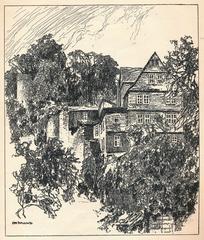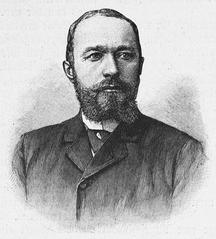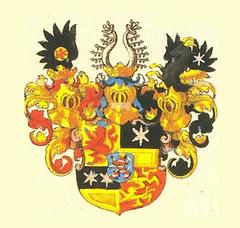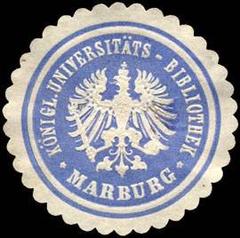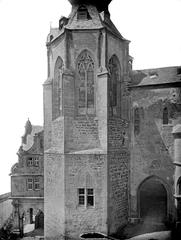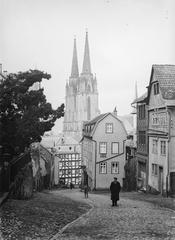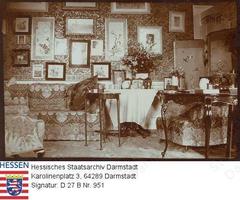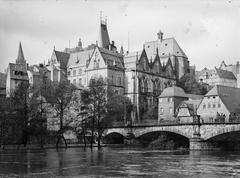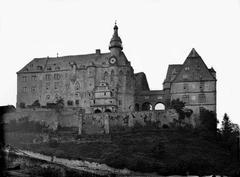
Kalbstor Marburg Visiting Hours, Tickets, and Travel Guide
Date: 03/07/2025
Introduction: Historical Significance and Visitor Overview
Located in the heart of Marburg’s Oberstadt, the Kalbstor is a remarkable relic of medieval Germany. Erected between 1230 and 1235, this stone gate once formed a strategic part of Marburg’s defensive fortifications, reflecting the town’s architectural heritage and historical importance. Today, Kalbstor is the only surviving and publicly accessible medieval city gate in Marburg, inviting visitors to step back in time amid cobblestone streets and half-timbered houses (tourenplaner-rheinland-pfalz.de; komoot.com).
Beyond its architectural grandeur, Kalbstor stands as a cultural symbol of Marburg’s resilience, having endured warfare, closure during the Thirty Years’ War, and eventual reopening in the 19th century. Its name, derived from the Ritter von Kalb family, echoes the medieval tradition of entrusting city defenses to local nobility (komoot.com). Today, Kalbstor is freely accessible, offering a passage through Marburg’s medieval past and connecting visitors to nearby attractions such as Kugelkirche, Elisabethkirche, and Marburg Castle (marburg-tourismus.de; germansights.com).
Contents
- Introduction
- History and Construction
- Name and Guardianship
- Role in Marburg’s Fortifications
- The Thirty Years’ War and Closure
- Reopening and Preservation
- Kalbstor’s Place in Urban Development
- Architectural Features and Current State
- Practical Visitor Information
- Visiting Hours
- Tickets and Entry
- Accessibility
- Guided Tours and Events
- Nearby Attractions
- FAQ
- Conclusion and Call to Action
- Additional Resources
History and Construction
The Kalbstor is Marburg’s only surviving medieval gate, built between 1230 and 1235 during a period of significant urban expansion (tourenplaner-rheinland-pfalz.de; komoot.com). This era saw Marburg rise as a religious, commercial, and military center, particularly after the establishment of Marburg Castle and the arrival of the Teutonic Order (germansights.com). Kalbstor was a crucial component of a robust stone wall that encircled the town, forming the primary western entrance to the Oberstadt (homeoftravel.de). Its late Romanesque style is evident in its massive stonework and rounded arches.
Name and Guardianship
The gate’s name honors the noble Ritter von Kalb family, who were historically responsible for the gate’s defense (komoot.com). Such naming reflected the medieval custom of assigning city defense duties to prominent local families.
Role in Marburg’s Fortifications
Kalbstor was part of an extensive city wall built in the late 12th and early 13th centuries (komoot.com; wikipedia.org). Beyond its defensive purpose, the gate controlled trade and movement into Marburg, serving as a checkpoint for goods and travelers. Its location near the Kugelkirche and the Oberstadt’s cobblestone streets made it a vital hub for commerce and defense (tourenplaner-rheinland-pfalz.de).
The Thirty Years’ War and Closure
At the outbreak of the Thirty Years’ War (1618–1648), the Kalbstor was closed to fortify the city against threats, and it remained sealed for over two centuries (tourenplaner-rheinland-pfalz.de). This closure demonstrates the long-term effects of the conflict on Marburg’s urban life.
Reopening and Preservation
In 1874, the gate was reopened as part of efforts to restore and modernize Marburg’s historic center (komoot.com). The Kalbstor now stands as a symbol of Marburg’s perseverance and is accompanied by remaining segments of the original city wall (homeoftravel.de).
Kalbstor’s Place in Urban Development
Strategically positioned at the crossroads of major medieval trade routes, the Kalbstor functioned as the main western gateway, connecting Marburg with the Lahn valley and beyond (wikipedia.org). The semicircular layout of the city wall and the placement of its four main gates reflect sophisticated urban planning and military engineering of the High Middle Ages (komoot.com).
Architectural Features and Current State
Kalbstor displays late Romanesque architectural elements, including thick stone walls and a vaulted passageway (komoot.com). While not all original structures remain, the gate’s medieval character endures. Its proximity to the Kugelkirche and half-timbered houses enhances its visual appeal and makes it a favorite spot for visitors and photographers (homeoftravel.de).
Practical Visitor Information
Visiting Hours
- Kalbstor: Open-air monument accessible 24/7; there are no gates or barriers.
- Nearby museums and guided tours: Generally operate Tuesday to Sunday, 10:00 AM – 5:00 PM; closed Mondays. Check local sources for seasonal changes.
Tickets and Entry
- Kalbstor: Free to access at any time; no ticket required.
- Guided tours or nearby attractions: May charge a fee; tickets are available online or at local visitor centers.
Accessibility
The area features cobblestone streets and some inclines; while accessible to most, visitors with mobility challenges should consult Marburg Tourist Information for details on accessible routes.
Guided Tours and Events
Kalbstor is included in many guided walking tours of Marburg’s Oberstadt, which can be booked through the tourist office. The site is also a backdrop for cultural festivals and community events celebrating Marburg’s medieval heritage.
Nearby Attractions
- Kugelkirche: Unique round church a short walk away.
- Elisabethkirche: Early Gothic church and pilgrimage site.
- Marburg Castle: Offers panoramic views and museum exhibits.
- Marburg Altstadt: Explore the Marktplatz, Altes Rathaus, and picturesque half-timbered houses.
Frequently Asked Questions (FAQ)
Q: Is there an entrance fee to visit Kalbstor?
A: No, the monument is free to access at all times.
Q: What are the opening hours for Kalbstor?
A: Kalbstor is an outdoor site, accessible 24/7. Museum exhibits and tours have specific hours.
Q: Are guided tours available?
A: Yes, walking tours including Kalbstor can be arranged through the tourist office.
Q: Is the site accessible for people with disabilities?
A: The area is mostly accessible, but cobblestones and slopes may present challenges. Consult the tourist office for details.
Q: What else can I see nearby?
A: Highlights include Marburg Castle, Elisabethkirche, Kugelkirche, and scenic medieval streets.
Visitor Experience and Tips
- Best Times to Visit: Spring and autumn offer beautiful surroundings; early mornings and late afternoons provide the best light and fewer crowds.
- Footwear: Wear comfortable shoes for uneven surfaces.
- Weather: Bring a rain jacket in case of sudden changes.
- Safety: The area is safe, but remain aware of your belongings.
- Photography: Dawn and dusk offer the most atmospheric lighting for photos.
How to Get There
Kalbstor is situated at the western edge of Marburg’s Oberstadt and is best reached on foot from the town center. Marburg main train station is about 1.2 km away, with bus connections available. For drivers, parking is available at the Oberstadt parking facility; note that vehicle access in the old town is restricted to preserve the historic core.
Sustainability and Responsible Tourism
Help preserve Kalbstor by respecting the site, not climbing on the walls, and supporting local businesses. Dispose of litter responsibly and contribute to the preservation of Marburg’s unique heritage.
Conclusion and Call to Action
Kalbstor is an essential landmark for understanding Marburg’s medieval history and architectural legacy. Its central location, free and unrestricted access, and proximity to other attractions make it a highlight of any visit to Marburg. For guided tours, local maps, and up-to-date information, consult Marburg Tourist Information.
To enhance your experience, download the Audiala app for audio tours and insider tips. For detailed inspiration, check related guides on Marburg’s Oberstadt, Elisabethkirche, and Marburg Castle. Follow local tourism channels for the latest events and travel updates.
Additional Resources
- The Tourist Checklist: Things to Do in Marburg
- Komoot’s Marburg Guide
- Knightstemplar.co: Castle Marburg
- Lahnwanderweg Kalbstor
- Marburg Tourist Information
- Germansights: Marburg

